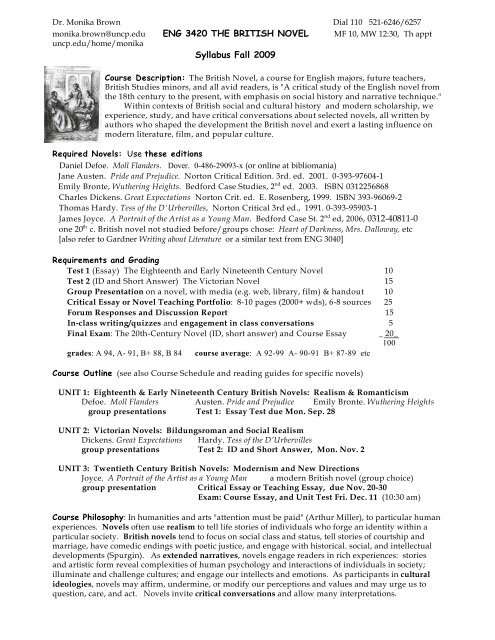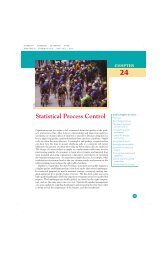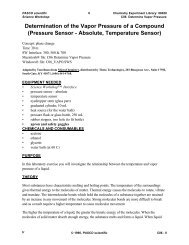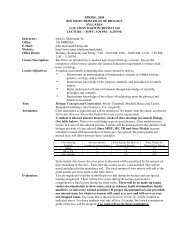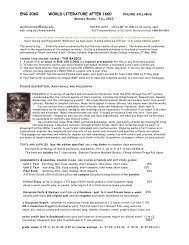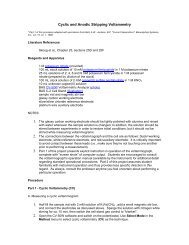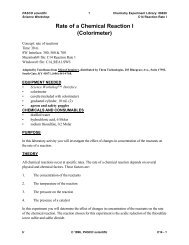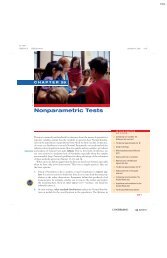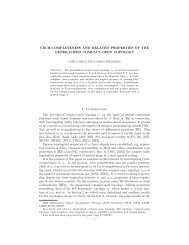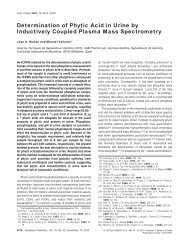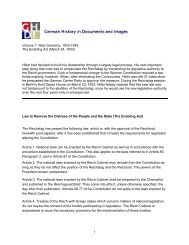monika.brown@uncp.edu ENG 3420 THE BRITISH NOVEL Syllabus ...
monika.brown@uncp.edu ENG 3420 THE BRITISH NOVEL Syllabus ...
monika.brown@uncp.edu ENG 3420 THE BRITISH NOVEL Syllabus ...
You also want an ePaper? Increase the reach of your titles
YUMPU automatically turns print PDFs into web optimized ePapers that Google loves.
Dr. Monika Brown Dial 110 521-6246/6257<br />
<strong>monika</strong>.<strong>brown@uncp</strong>.<strong>edu</strong> <strong>ENG</strong> <strong>3420</strong> <strong>THE</strong> <strong>BRITISH</strong> <strong>NOVEL</strong> MF 10, MW 12:30, Th appt<br />
uncp.<strong>edu</strong>/home/<strong>monika</strong><br />
<strong>Syllabus</strong> Fall 2009<br />
Course Description: The British Novel, a course for English majors, future teachers,<br />
British Studies minors, and all avid readers, is "A critical study of the English novel from<br />
the 18th century to the present, with emphasis on social history and narrative technique."<br />
Within contexts of British social and cultural history and modern scholarship, we<br />
experience, study, and have critical conversations about selected novels, all written by<br />
authors who shaped the development the British novel and exert a lasting influence on<br />
modern literature, film, and popular culture.<br />
Required Novels: Use these editions<br />
Daniel Defoe. Moll Flanders. Dover. 0-486-29093-x (or online at bibliomania)<br />
Jane Austen. Pride and Prejudice. Norton Critical Edition. 3rd. ed. 2001. 0-393-97604-1<br />
nd<br />
Emily Bronte, Wuthering Heights. Bedford Case Studies, 2 ed. 2003. ISBN 0312256868<br />
Charles Dickens. Great Expectations Norton Crit. ed. E. Rosenberg, 1999. ISBN 393-96069-2<br />
Thomas Hardy. Tess of the D'Urbervilles, Norton Critical 3rd ed., 1991. 0-393-95903-1<br />
nd<br />
James Joyce. A Portrait of the Artist as a Young Man. Bedford Case St. 2 ed, 2006, 0312-40811-0<br />
th<br />
one 20 c. British novel not studied before/groups chose: Heart of Darkness, Mrs. Dalloway, etc<br />
[also refer to Gardner Writing about Literature or a similar text from <strong>ENG</strong> 3040]<br />
Requirements and Grading<br />
Test 1 (Essay) The Eighteenth and Early Nineteenth Century Novel 10<br />
Test 2 (ID and Short Answer) The Victorian Novel 15<br />
Group Presentation on a novel, with media (e.g. web, library, film) & handout 10<br />
Critical Essay or Novel Teaching Portfolio: 8-10 pages (2000+ wds), 6-8 sources 25<br />
Forum Responses and Discussion Report 15<br />
In-class writing/quizzes and engagement in class conversations 5<br />
Final Exam: The 20th-Century Novel (ID, short answer) and Course Essay _ 20_<br />
100<br />
grades: A 94, A- 91, B+ 88, B 84 course average: A 92-99 A- 90-91 B+ 87-89 etc<br />
Course Outline (see also Course Sch<strong>edu</strong>le and reading guides for specific novels)<br />
UNIT 1: Eighteenth & Early Nineteenth Century British Novels: Realism & Romanticism<br />
Defoe. Moll Flanders Austen. Pride and Prejudice Emily Bronte. Wuthering Heights<br />
group presentations Test 1: Essay Test due Mon. Sep. 28<br />
UNIT 2: Victorian Novels: Bildungsroman and Social Realism<br />
Dickens. Great Expectations Hardy. Tess of the D’Urbervilles<br />
group presentations Test 2: ID and Short Answer, Mon. Nov. 2<br />
UNIT 3: Twentieth Century British Novels: Modernism and New Directions<br />
Joyce. A Portrait of the Artist as a Young Man a modern British novel (group choice)<br />
group presentation Critical Essay or Teaching Essay, due Nov. 20-30<br />
Exam: Course Essay, and Unit Test Fri. Dec. 11 (10:30 am)<br />
Course Philosophy: In humanities and arts "attention must be paid" (Arthur Miller), to particular human<br />
experiences. Novels often use realism to tell life stories of individuals who forge an identity within a<br />
particular society. British novels tend to focus on social class and status, tell stories of courtship and<br />
marriage, have comedic endings with poetic justice, and engage with historical. social, and intellectual<br />
developments (Spurgin). As extended narratives, novels engage readers in rich experiences: stories<br />
and artistic form reveal complexities of human psychology and interactions of individuals in society;<br />
illuminate and challenge cultures; and engage our intellects and emotions. As participants in cultural<br />
ideologies, novels may affirm, undermine, or modify our perceptions and values and may urge us to<br />
question, care, and act. Novels invite critical conversations and allow many interpretations.
<strong>Syllabus</strong> <strong>ENG</strong> <strong>3420</strong> <strong>THE</strong> <strong>BRITISH</strong> <strong>NOVEL</strong> p.2<br />
Objectives: In <strong>ENG</strong> <strong>3420</strong>, students experience and learn about novels, cultural history, and criticism<br />
and they develop--by active learning--skills, concepts, and habits of mind for advanced literary study.<br />
As you take and complete the course, you meet English Major program objectives and are able to:<br />
1. explain content, themes, and features of representative British novels, from two centuries when the<br />
novel became and remained the dominant literary genre in America and Europe;<br />
2. explain, with increasing confidence, features of the novel as a literary genre rooted in realism--its<br />
evolution, flexibility, diversity, and narrative strategies--and apply this formalist expertise to analysis,<br />
interpretation, close reading, and evaluation of British novels and film adaptations;<br />
3. relate a few British novels to their contexts, especially transformations in British society, culture,<br />
th<br />
th<br />
and ideology from the early 18 to the mid-20 century: social class divisions and mobility; rural and<br />
urban settings for work and social interactions; family life and women’s roles; pursuit of individual selffulfillment<br />
and <strong>edu</strong>cation within social and psychological constraints; exposure to new places, historical<br />
changes, and global cultures; scientific discoveries and psychological insights; religious beliefs and<br />
secularization; and readership, authors, publications, and other media;<br />
4. engage with critical texts and critical approaches as you analyze how British novels are shaped by,<br />
illuminate, challenge, and leave their mark on: biography and psychology, national cultures and<br />
languages, other works of art and media, gender and ethnic diversity, power relations of their own and<br />
other cultures, and modern popular culture;<br />
5. develop expertise in critical speaking and writing: close critical reading, critical conversations,<br />
source integration, library research, internet use, and applications to teaching and to creative writing;<br />
6. experience aesthetic pleasure as well as personal growth as readers and writers of fiction, as<br />
prospective teachers, and as lifelong learners who are appreciative of literature as art, sensitive to values<br />
and social problems, and respectful of diversity.<br />
UNCP Teaching Standard 1 is thus also addressed: The teacher candidate commands essential<br />
knowledge and understandings of the academic discipline(s) from which school subject matter is derived<br />
and integrates that knowledge into personally meaningful frameworks.<br />
Class Proc<strong>edu</strong>res and Activities<br />
The success of this course, which engages all levels of the learning pyramid, depends on each and all<br />
of you. You are expected to read and write, talk and listen and teach, research and collaborate, interpret<br />
and connect, make and defend judgments, examine your responses, question and care.<br />
While the course design, textbooks, Literature Guide, short lectures, and forum topics provide a<br />
"road map" structure, in this course students will shape many of the classroom conversations.<br />
Class sessions engage you with literature through film clips, power-point slides, and internet sites, as<br />
well as class conversations and group activities. Blackboard discussion forum responses and reports<br />
allow you to begin and continue conversations outside the classroom.<br />
As novel readers, you interpret and discuss content and insights into experience: beginnings,<br />
character psychology and conflicts, settings and society, climaxes, and endings. As literature students<br />
you also read passages closely and analyze formal features of realist, romantic, and modernist novels<br />
(point of view, characterization, plot, narration, style); relate literary works to historical and cultural<br />
contexts and critical theories; examine influences and adaptations; and evaluate quality.<br />
Class Policies: To succeed in this course, and enhance the course experience for everyone,<br />
Attend all classes, on time After 3 absences, you lose 1 point from your average per unexcused<br />
absence; 9 absences for any reason means F in the course. If you miss class, be prepared for the<br />
next class; for a missed test or a late assignment, ask for an extension or makeup in advance.<br />
Turn in your best work, on time. If work must be late, ask for an extension; don’t skip class.<br />
Commit yourself to class: keep up with work (5-6 hrs/week outside class), follow directions, bring<br />
& mark your books, contribute, learn from each other, be courteous& attentive-no electronics out<br />
Ask for help with any work--before it is due--from the instructor, students, or the writing center;<br />
use the writing center for skill practice: essay form, writing process, proofreading, documenting.<br />
Learn by revising. Turn in a revision of an early test or paper with original work attached. On a test,<br />
you may earn up to half of lost points; on an essay, the new grade is averaged with the original.<br />
Abide by the Honor Code: give MLA credit for borrowed ideas, use quote marks when you copy.<br />
Plagiarism as fraud, knowingly presenting another’s work as your own, means F in the course.<br />
ADA Policy: A student with a documented disability needing academic adjustments should<br />
speak in the first week of class to the instructor and to Mary Helen Walker, Disability Support<br />
Services, DF Lowry building, 521-6695. All discussions remain confidential.
<strong>Syllabus</strong> <strong>ENG</strong> <strong>3420</strong> <strong>THE</strong> <strong>BRITISH</strong> <strong>NOVEL</strong> p.3<br />
EXPLANATION OF MAIN ASSIGNMENTS<br />
Presentation: A Novel Context (small group) (10%)<br />
Prepare and present, in a group of 2 or 3, a 15-20 minute presentation on a topic related to a novel we<br />
study. Use films, performances, powerpoint, web sites, youtube, or other creativity; engage the class.<br />
Suitable topics for presentations (a signup sheet will circulate) include:<br />
the influence of publication conditions (e.g. alternate endings of Great Expectations);<br />
the reception of the novel (and its characters, themes, literary features) by its early readers<br />
relevant aspects of an author's life or other works by the same author; relate to our novel<br />
aspects of social/cultural context (classes&codes, work, women's lives, art, other texts)<br />
film adaptations and film scenes or web sites and/or popular culture treatments<br />
recent critical positions or controversies<br />
At the time of the presentation, the group distributes to the class copies of a relevant handout (about 2<br />
pages), which may include: an outline or summary of your presentation, quotations from reviewers or<br />
other sources, illustrations or settings or maps, film outlines, time lines, or other suitable information<br />
plus (required) a Works Consulted list, MLA format, that students can use for research.<br />
Evaluation: Presentations are evaluated for the quality of preparation, presentation (content,<br />
organization, delivery, timing), media use, & handout; the instructor seeks responses from students<br />
as needed, writes a critique, and assigns a group grade or, when appropriate, individual grades.<br />
Critical Essay or Novel Teaching Essay (using sources) (see Assignments, 25%)<br />
Early in the semester, browse all novels in the course and/or view film adaptations and select a<br />
favorite novel for closer study. You may select a post-1920 British novel that is not part of this course<br />
with Dr. Brown’s approval. Each gives you in-depth knowledge of a British novel and related<br />
criticism. Sample papers will be available on Blackboard and in the English library.<br />
The Critical Essay, about 2500 words (8-10 typed pages), has a Works Cited page lists (in addition<br />
to the novel), 6-8 critical articles, web sites (1 or 2, good quality) and/or books. Within the paper, use<br />
quotations and paraphrases from the sources, giving credit with in-text documentation in MLA<br />
format. While such papers resemble short conference papers, journal articles, or book chapters, you<br />
may use a creative genre if you can adapt it to the guidelines for the assignment. A critical essay is an<br />
argument that presents your interpretation of a literary work: the evidence is mainly information and<br />
quotations that you select from the novel. Critical writings that support or refute your thesis are<br />
incorporated into your essay. Write a rough draft of your thoughts before doing extensive research,<br />
so that you are not overwhelmed by what others have written.<br />
For a Novel Teaching Essay, select a British novel from this course (or a similar classic) that you<br />
would like to teach in grades 6-8 or 9-12. Find and reading professional articles and book chapters in<br />
which literature teachers explain how they teach this novel, or teach British literature, or the novel as a<br />
genre. These will suggest relevant literary criticism and other resources. Based on your study of the<br />
novel and of the sources you find (Works Cited), write a coherent professional essay (2500 words) that<br />
covers these topics: argue for teaching the novel; analyze features worth teaching; survey strategies<br />
and assignments used by teachers--with novels in general, British novels, and this novel; and propose a<br />
short unit for teaching the novel. Attach copies of the best resources; perhaps create one of your own.<br />
Blackboard Discussion Forum Responses and Report (15%)<br />
About every other week, on a rotating sch<strong>edu</strong>le (Group A, Group B), each student contributes a<br />
Forum Response essay on Blackboard. By 9pm, post a mini-essay that prepares for class conversation<br />
the next class day. Typical answers (400+ words plus quotes) have: a) 1-2 general insights that<br />
respond to a question or introduce a topic you choose; b) some specific explanations, examples,<br />
paraphrases; c) 2-3 key quotes from the literary text, with comments. A few forums are designed for<br />
close reading or for responding to criticism. For full credit, bring your post to class, talk about it in<br />
class, and comment in most forums. Each student also writes one Discussion Report that synthesizes<br />
discussion about one Forum topic. (see Discussion Board for directions)<br />
Class writing/quizzes/conversations (5%) Quizzes/writing (10 min.) reward those who read<br />
actively and take notes, provide close reading practice, initiate class discussion, and let Dr. Brown<br />
know how you understand details and concepts. Contributions to class conversation count equally.<br />
A Final Exam Essay on a Course Theme or Your Course Journey (50 points of exam)<br />
For the Final Exam Essay (50% of the test), you write about how a significant feature of British<br />
society or culture or the British novel evolved over the 250 years covered in this course. To prepare,<br />
select two or three social or cultural or literary transformations from those in Objective 3, above, and<br />
focus on one or more as you read novels, write responsess, contribute to class, and write a Critical<br />
Essay or Teaching Essay. OR You may reflect about your course journey, how you developed as a<br />
critical reader and writer, novel reader (perhaps future teacher, writer, or reader), through studying<br />
British novels, posting to forums, contributing to conversations, taking tests, and other classwork.
<strong>ENG</strong> <strong>3420</strong> <strong>THE</strong> <strong>BRITISH</strong> <strong>NOVEL</strong> UNIT 1 M. Brown 2009<br />
TH<br />
TH<br />
UNIT I: <strong>THE</strong> 18 to EARLY 19 CENTURY <strong>NOVEL</strong>: REALISM & ROMANTICISM<br />
A. Defoe’s Mo ll Fland e rs and the rise of the novel [see Moll Flanders handout; text at readprint.com/]<br />
st<br />
F Aug. 21 Moll Flanders preface & ch. 1-2 (childhood, 1 marriage) : psychology of decisions (mark passages)<br />
th<br />
Rise of the Novel: 18 c. Britain and Defoe’s “autobiographies”<br />
M Aug. 24 Moll Flanders: [ch.3-8/bibliomania ch.1-12] & summary<br />
1. character psychology: Moll as wife, mother: traits, decisions, motives; 2. social setting Moll’s world<br />
Response A1, by Tu. 9pm: Moll’s later adventures and the ending<br />
W Aug. 26 Moll Flanders: summary, selections from later chapters [ch. 9-14/bibliomania ch. 13-22]<br />
3. character psychology&development Moll as thief&penitent;<br />
4. social values, Defoe’s art: feminist&Marxist views<br />
B. Jane Austen’s Prid e and Pre jud ic e and reading a realist novel<br />
F Aug. 28 (bring Pride and Prejudice)<br />
Development of the Novel, 18th-19th: Richardson Pamela; FieldingTom Jones; Jane Austen<br />
M Aug. 31 Pride and Prejudice Vol. 1 ch. 1-18 22; also Austen bio link & Van Ghent, 299-303<br />
st<br />
1. Elizabeth and Darcy, psychology; scenes and quotes; pride&prejudice, 1 impressions<br />
Response B1, by Tu 9pm, based on readings for Wed. (see forum for details)<br />
W Sep 2 Pride and Prejudice, Vol.1, ch.19-Vol. 2 ch.15 (esp. ch. 11-13); Van Ghent 303-7<br />
2. social analysis, social settings, and Austen’s art & irony; secondary and comic characters<br />
3. character psychology; characterization & style proposal scene, letter, and E’s response<br />
F Sep. 4 Pride and Prejudice, Vol. 2 ch.13-19; Vol. 3. ch. 1-4, and Duckworth 311-12<br />
4. social analysis, symbolic setting, characters, and Austen’s art: Elizabeth and Darcy at Pemberley<br />
5. character psychology & development and plot structure: Elizabeth and Darcy’s progress to reconciliation<br />
M Sep. 7 Labor Day<br />
W Sep. 9 Pride and Prejudice, Vol. 3 ch. 5-19 and whole novel<br />
6. ending and humanist/social insights: values, significance of marriage<br />
7. ending and feminist interpretation: changes in Elizabeth, E&D relationship<br />
Responses A2 and B2, by Thu 9pm, bases on the whole novel&one critical article<br />
F Sep. 11 Pride and Prejudice interpretations and criticism<br />
humanist-Duckworth/reconciliation; 306, Morgan/perception 338; feminist-Fraiman/humiliation 359<br />
M Sep. 14 view P&P film scenes on youtube and read about Darcy on film 384-91/skip 388<br />
Presentation: Austen and/or Pride and Prejudice<br />
C. Emily Bronte’s Wuth e ring He ig h ts, the Romantic novel, and critical perspectives<br />
M Sep. 14 The Romantic Novel: historical (Scott), gothic (Radcliffe, Shelley), Brontes<br />
W Sep. 16 Bronte bio, 3-14; Wuthering Heights ch 1-6<br />
1. opening events, main characters, point of view&style: narrators, surprises<br />
Response A3 by Th. 9pm: ch. 6-17 and criticism<br />
F Sep. 18 Wuthering Heights, ch. 5-17; critic-Eagleton (Marxist) 390-91&394-403<br />
2. setting&society: Wuthering Heights, Thrushcross Grange (1801; 1770s-80s)<br />
3. characters&scenes: Catherine&Heathcliff, traits/decisions; Marxist-Eagleton<br />
M Sep. 21 Wuthering Heights, ch.18-34 ; Eagleton (Marxist), 403-410<br />
4. character complexity and development: Heathcliff as hero/villain<br />
5. characters, setting & society the second generation and the ending<br />
Response B3 by Th. 9pm, whole novel and critical perspectives<br />
W Sep. 23 Wuthering Heights critics: Wion (psychoanalytic) 357, 364ff or Pykett (feminist) 358, 368ff<br />
6. the two Catherines, and psychoanalytic and feminist insights from Wion and Pykett<br />
F Sep. 25 Read Critical/Teaching Essay assignment&sample; bring P&P, WuthHts, GrEx., Tess, Portrait<br />
Presentation: Bronte and/or Wuthering Heights (see Gothic Novel ppt by Kristin Meurer)<br />
Critical Essay/Teaching Essay Workshop 1: directions, topic ideas, plans<br />
M Sep. 28 Unit 1 Test Essay Due
<strong>ENG</strong> <strong>3420</strong> UNIT 2 <strong>THE</strong> VICTORIAN <strong>NOVEL</strong> and SOCIAL REALISM M. Brown 2009<br />
A. Charles Dickens, Gre at Exp e c tatio ns: Bildungsroman, social panorama, and multiple plots<br />
M Sep. 28 The Victorian Age and the Victorian Novel<br />
W Sep. 30 Dickens’s life and career, skim Norton 721-27; Gre at Exp e c tatio ns, ch. 1-6, map p.6<br />
1. Impressions & art of the novel: early experiences, point of view, gothic & grotesque, settings, style<br />
F Oct. 2 Great Expectations, vol 1, ch. 7-19, map p. 46<br />
2. Pip’s character and experiences: home, Miss Havisham’s, Biddy’s school, Joe’s forge, new chance<br />
3. settings, characters , social classes: marshes/convict, Joe&Mrs.Joe & Biddy; Miss H’&Estella/town,<br />
M Oct. 5 Great Expectations, vol 2, ch. 20-31, London map p.126; social class chart-syllabus and BB<br />
4. settings, characters and social classes: London, Pocket school, students, lawyers<br />
Response B4 by Tu 9pm, Pip’s social rise<br />
W Oct. 7 Great Expectations vol. 2: rev. ch. 20-31; ch.32-39, critical passage from House or Gilmour<br />
5. character psychology, character development and social rising: Pip’s achievements and disappointments<br />
F Oct. 9 Presentation: Great Expectations<br />
Mid-Victorian Novelists: Dickens, Thackeray, George Eliot<br />
Response A4 by Sun 10pm: plots and themes<br />
M Oct.12 Great Expectations, vol. 3, ch. 40-59 critical passage(s) from handout, Brooks, or Walsh<br />
6. Bildungsroman and themes: Pip’s new experiences, changes, and endings<br />
7. other plots & themes: Estella, Miss H., Magwitch; repressed plots, gothic, detective, “sensation” crime<br />
8. Dickens’s social and moral values<br />
Critical Essay or Teaching Essay: post topic statement (Tue)<br />
W Oct. 14 read sample essays on BB; bring essay topic statement, novel for your essay, 2 journal articles<br />
Presentation: Dickens and/or Great Expectations<br />
Critical/Teaching Essay: Workshop 2 revising topic statements, research<br />
F Oct 16 Fall Break<br />
B. Thomas Hardy, Te ss o f th e D’Urb e rville s: novel of social change; close/critical reading<br />
st<br />
nd<br />
M Oct. 19 Thomas Hardy, Tess of the D’Urbervilles, Phase 1 ch. 1-11; Phase 2 ch.12-15<br />
1. events&character traits: Tess's early experiences; who bears responsibility<br />
2. symbolic setting (place, people, activity, symbol): Marlott, Trantridge, Chaseboro, Chase<br />
rd<br />
th<br />
W Oct. 21 Tess, Phase 3 ch.16-24 (review psych & feminist questions)<br />
3. psychological: what is Angel Clare like? what does he see in Tess? ready to marry?;<br />
Marxist: find a passage that shows how social class and social change shape him<br />
4. feminist: what is Tess like? what does she see in Angel? ready to marry? (Poole 476)<br />
Critical/Teaching Essay: post outline or partial draft (Th)<br />
th<br />
F Oct. 23 Tess Phase 4 ch. 25-34 (review ch.18-22 & Marxist, cultural)<br />
5. climax explain-choose crit approach Angel’s decision&Tess response (386, Williams461,63,67, Howe 415-6)<br />
Marxist: find a passage that shows how social class and social change shape her decisions<br />
Response A5: close reading, critical reading by Th 9pm<br />
th th<br />
M Oct. 26 Tess, Phase Phase 5 -6 ch 35-44 (choose critical approach, including myth/archetype criticism)<br />
6. setting&social change: ch.41-42 walk&Flintcombe Ash (Marxist/cult. Williams 461, 470-1; Howe 417)<br />
7. character change&theme: state&argue for an interpretation of Tess that accounts for later decisions.<br />
Response B5: close reading, critical reading, by Tu. 9pm<br />
th<br />
W Oct. 28 Tess Phase the 7 /ending, ch. 45-59<br />
8. character change & theme: state & argue for an interpretation of Angel that accounts for later decisions<br />
9. ending and close reading of passages, for narrative strategy, figurative language, allusions, symbolism<br />
F Oct. 30 Tess and Hardy, conclusions; Test 2 plans<br />
10. conclusions about Tess and the novel: Hardy prefaces vix, interview 387, Howe 420-2, Poole 482-4<br />
Presentation on Hardy and/or Tess<br />
M Nov.2 Test on Unit 2: Realist Novels of the Victorian Age (ID, short answer, prepared mini-essay)
<strong>ENG</strong> <strong>3420</strong> UNIT 3 <strong>THE</strong> MODERN <strong>BRITISH</strong> <strong>NOVEL</strong> and MODERNISM M. Brown 2009<br />
A. James Joyce, Po rtrait o f th e Artist as a Yo ung Man (see Study Guide): the British modernist novel<br />
W Nov. 4 The Modernist Novel and Joyce; the Irish context<br />
Intro to Joyce’s Portrait and Joyce’s style (see Portrait Study Guide)<br />
Critical Essay/Teaching Essay: post good draft w/ works cited Thu 9pm<br />
F Nov. 6 Critical/Teaching Essay Workshop 3: discuss topics, research<br />
M Nov. 9 A Portrait of the Artist, ch. 1: childhood<br />
1. Notice what little Stephen is like: how typical, special; what interests him/gives him pleasure<br />
2. Keep track, for 1 theme, of what is going on (family/city/politics, <strong>edu</strong>c/men/relig, women/sex)<br />
3. Notice modernist features of Joyce’s novel<br />
W Nov. 11 A Portrait of the Artist, ch. 2-3: adolescence<br />
4. Ch. 2: in each new situation, notice Stephen’s alienation, what repels him, escape attempt, result<br />
5. Ch. 3: notice buildup to Stephen’s religious crisis and reflect on what course his life will take<br />
Response A6 by Thu 9pm<br />
F Nov. 13 A Portrait of the Artist, ch. 4, Stephen’s epiphanies<br />
6. Ch. 4: close read a specific passage (class groups prepare ahead)<br />
Response B6 by Thu 9pm<br />
M Nov. 16 A Portrait of the Artist, review ch. 4; ch. 5: Stephen's calling, ending<br />
7. Ch. 4-5: Stephen defines what kind of artist he’ll be: close read a specific passage<br />
8. Ending: Stephen’s plans, final epiphanies, future<br />
Critical Essay/Teaching Essay: post revised draft (Tues)<br />
W Nov. 18 bring to class: Critical Essay/Teaching Essay-Revised draft and 3-4 sources<br />
Critical/Teaching Essay Workshop 4, based on posted drafts<br />
Presentation on Joyce and/or Portrait of the Artist<br />
B. Modern and Contemporary British and Postcolonial Novels: Novel Reading Groups<br />
Nov.20-30 Critical Essay or Teaching Essay: turn in with draft, responses, 3 sources<br />
F Nov. 20 British Modernist Novelists: Conrad, Woolf, Lawrence<br />
Novel Reading Groups plan<br />
Response A7/B7, for your novel reading group, based on half the novel, by Sun. 9pm<br />
M Nov. 23 read half of your group’s novel; Novel Reading Groups meet in class<br />
W/F Nov. 25, 27 Thanksgiving Holiday<br />
M Nov. 30<br />
W Dec. 2<br />
F Dec. 4<br />
finish reading your group’s novel; Novel Reading Groups meet in class<br />
Post final Critical Essay or Teaching Essay in appropriate Forum<br />
Modernism and After: New British and Postcolonial Novels; Novel Reading Groups report to class<br />
Course Conclusions and Exam Essay Discussion<br />
F Dec. 11 10:30<br />
Final Exam (bring and post Exam Essay)
<strong>ENG</strong> <strong>3420</strong> <strong>THE</strong> <strong>BRITISH</strong> <strong>NOVEL</strong>: SELECTED RESOURCES 2009<br />
for internet sites and links, use links pages on Blackboard and at uncp.<strong>edu</strong>/etl and uncp.<strong>edu</strong>/home/<strong>monika</strong><br />
I. The Novel: Classic & Contemporary Studies, Collections, Reading Guides<br />
Bakhtin, M.M. The Dialogic Imagination. Trans. C. Emerson&M. Holquist. Austin: U Texas P, 1981. (multi-voices)<br />
Booth, Wayne C. A Rhetoric of Fiction. Chicago: U of Chicago P, 1961. 2nd ed. 1989. PN3451.B6 1966. [point of view]<br />
Brooks, Peter. Reading for the Plot: Design and Intention in Narrative. Cambridge, Ma.: Harvard UP, 1992.<br />
Cohn, Dorrit. The Distinction of Fiction. Hopkins, 1999; Transparent Minds. Princeton UP 1978. PN3448.P8 C6<br />
Forster, E. M. Aspects of the Novel. 1927. New York: Harcourt, Brace, 1954. techniques of fiction<br />
th<br />
Hawthorn, Jeremy. Studying the Novel. 4 ed. London: Arnold, 2001. history, analyis, critical approaches<br />
Lodge, David. The Art of Fiction. New York: Viking, 1993: 50 fiction techniques with examples from novel texts<br />
Lubbock, Percy. The Craft of Fiction. New York: Viking, 1957. classic of formalist analysis<br />
McKeon, Michael, ed. Theory of the Novel: A Historical Approach. Baltimore: Johns Hopkins, 2000. [incl. Cohn, Baktin]<br />
Scholes, Robert, & Robert Kellogg. The Nature of Narrative. London: Oxford UP, 1966. [theory of narrative writing]<br />
Stevick, Philip, ed. The Theory of the Novel. New York: Free Press, 1967. [fiction techniques]<br />
Spilka, Mark, and Caroline McCracken-Flesher, ed. Why the Novel Matters: A Postmodern Perplex. Indiana U P, 1990.<br />
Doody-realism, Armstrong-women&novel, Lodge-modern novel, Spacks&Scholes-ethics.]<br />
Walder, Dennis, ed. The Realist Novel. Approaching Literature. New York: Routledge/Open U, 1995.<br />
[integrates/excerpts classic/modern theoretical essays&analysis. Pride & Prejudice, Great Expectations, Frankenstein]<br />
II. The British Novel: Selected Surveys and Introductions<br />
Eagleton, Terry. The English Novel: An Introduction. Malden, MA: Blackwell, 2005.<br />
Gorman, Francis. ed. The Victorian Novel: A Guide to Criticism [survey of criticism, long excerpts]. Wiley-Blackwell, 2002<br />
Head, Dominic. The Cambridge Introduction to Modern British Fiction, 1950-2000. Cambridge UP, 2002.<br />
Schwarz, Daniel R. Reading the Modern British & Irish Novel 1890-1930. Blackwell 2004. [Hardy, Conrad, Woolf, Joyce]<br />
Seymour-Smith, Martin. Novels and Novelists: A Guide to the World of Fiction. New York: St. Martin’s, 1980.<br />
Skilton, David. Defoe to the Victorians: Two Centuries of the English Novel. Harmondsworth: Penguin, 1977<br />
Hewitt, English Fiction 1890-1940 (1988); Stevenson British Novel Since the Thirties (1986), Massie The Novel Today (1990)<br />
III. The British Novel in British Society: Selected Classic and Contemporary Studies<br />
Armstrong, Nancy. Fiction in the Age of Photography: The Legacy of British Realism. Cambridge, MA: Harvard UP, 1999.<br />
_______. Desire and Domestic Fiction: A Political History of the Novel. London: Oxford UP, 1987. [rise-women’s roles]<br />
_______. How Novels Think : The Limits Of British Individualism From 1719-1900. NY : Columbia U P, 2005.<br />
Buckley, Jerome. Season of Youth: The Bildungsroman from Dickens to Golding. Cambridge: Harvard U P, 1974.<br />
PR 830. A8 B8 [Great Expect, Mill Floss, Portrait of the Artist, Sons & Lovers ]<br />
David, Deidre, ed. The Cambridge Companion to the Victorian Novel. Cambridge: Cambridge UP 2001. [essays on topics]<br />
Fraiman, Susan. Unbecoming Women: British Women Writers and the Novel of Development. New York: Columbia UP, 1993.<br />
PR 830.W6.F3.1993. [ Evelina, Pride & Prejudice, Jane Eyre, Mill on the Floss.]<br />
Gallagher, Catherine. The Industrial Reformation of English Fiction : Social Discourse &... Form, 1832-1867. U Chicago, 1985<br />
Gilbert, Sandra M., and Susan Gubar. The Madwoman in the Attic: The Woman Writer and the Nineteenth-Century Literary<br />
Imagination. New Haven: Yale, 1979. PR 115.G5 [classic feminist/resistance; Austen, Shelley, C Bronte, Eliot]<br />
Guy, Josephine. The Victorian Social-Problem Novel: The Market, the Individual and Communal Life. NY: St. Martin’s, 1996.<br />
Hughes, Linda K and Michael Lund. The Victorian Serial. Charlottesville: UP of Virginia, 1991<br />
Hunter, J. Paul. Before Novels: The Cultural Contexts of Eighteenth-Century English Fiction. Norton 1990. [early readers]<br />
Ingham, Patricia. The Language of Gender & Class: Transformation in the Victorian Novel. London: Routledge, 1996<br />
Kucich, John. Repression in Victorian Fiction: Charlotte Brontë, George Eliot, Charles Dickens. U of California P, 1987.<br />
Langland, Elizabeth. Society in the Novel. U of NC P, 1984. formal qualities>fictional societies: Austen, Dickens, Hardy Leavis,<br />
F. R. The Great Tradition. London: Chatto & Windus, 1938. [moral & transform art :Austen, Eliot, Conrad]<br />
Levine, George. The Realistic Imagination: English Fiction from Frankenstein to Lady Chatterley. Chicago, ‘81. PR868.R4 L48.<br />
Marx, John. The Modernist Novel and the Decline of Empire. Cambridge UP, 2006. [Conrad, Joyce]<br />
McKeon, Michael, The Origins of the English Novel: 1600-1740. Baltimore: Johns Hopkins, 1987. PR841 .M3 1987.<br />
Miller, D. A. The Novel and the Police. Berkeley: U of California P, 1988. PR878.P59 M55 1988b. also e-book<br />
Polhemus, Robert M. Erotic Faith: Being in Love from Jane Austen to D. H. Lawrence. U Chicago P, 1990. [love as religion]<br />
Poovey, Mary. Uneven Developments: the Ideological Work of Gender in Mid-Victorian England. U Chicago P, 1988.<br />
______.The Proper Lady&the Woman Writer : Ideology As Style ...Wollstonecraft, Shelley, Austen. Chicago ‘84. PR469.W65 P66<br />
Showalter, Elaine. A Literature of Their Own: British Women Novelists from Bronte to Lessing. Princeton 1977. PR115 .S5<br />
Van Ghent, Dorothy. The English Novel: Form and Function. Harper & Row 1953, 1961. [formalist & psych/social ]<br />
Watt, Ian. The Rise of the Novel. Berkeley: U of California P, 1967. [realist fiction & English society] PR841 .M6 1963<br />
Williams, Raymond. The English Novel fr Dickens to Lawrence. London: Chatto & Windus, 1970. [cultural, vs. Leavis]<br />
Warhol, Robyn. Gendered Interventions:Narrative Discourse in the Victorian Novel. New Brunswick: Rutgers ‘89


